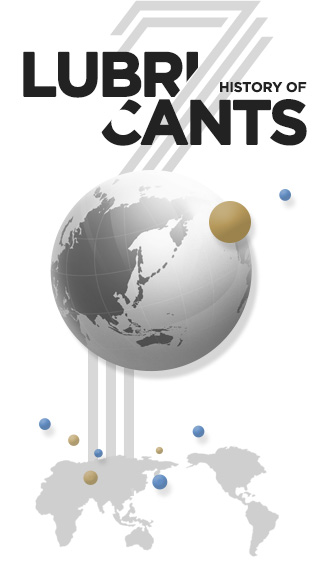BASIC INFORMATION


The concept of ‘lubricating oils’ or lubricants is presumed to be derived from the time when humans used tools. Lubricating oil has been used for a variety of purposes to prevent friction and corrosion on the clashing surfaces, suppress heat generation, keep objects clean, and create insulation and rust-preventive effects.
According to records, olive oil was used to move stone or lumber in constructing colossal buildings in ancient Egypt; since then tallow which is animal fat was used as lubricant in the wheel axes of trams. Grease which is used to describe lubricating materials originated from the Latin word ‘Grussu’ which means fat because grease looked similar to fat in the early days.
In the Middle Ages as complicated machines made from iron and cooper were widely used, various lubricating materials such as sperm oil, castor oil, peanut oil, and rape oil appeared. It was not intended to no longer use vegetable oil or animal fat and they were adopted mostly based on the experience of use instead of scientific analysis.
The history of modern lubricating oils began with the outset of oil drilling in Pennsylvania, the U.S. in the nineteenth century. At that time sperm oil was used as lubricant for spinning and weaving machine, but it was discovered incidentally that mixing with crude oil would extend the life of the machine to more than ten years. Since then, lubricants started being rapidly replaced by crude oil-based lubricant products.
In the mass production era of the twentieth century, machinery became more complicated and sophisticated, so that lubricating materials were needed to work in a harsh environment incomparable to that of the past. Through World War I and II, automobiles, aircrafts, diesel locomotives, missiles, and large vessels have been rapidly developed, driving the advancement of oil refining and lubricating products. A solvent refining method was invented in the 1920s and the use of additives to enhance the performance of lubricants proliferated across the industries in the 1930s.
In the 1950s, as a jet liner was introduced, the development of lubricants that work well even at the temperature lower than 50 degrees below zero was needed, resulting in the emergence of synthetic oil and multi-purpose oil. A hydrocracking method was developed in the 1970s and the more advanced hydroisomerization method was discovered in the 1990s, allowing the development and production of a wide range of high-quality lubricants using mineral oil which can compete with fully synthetic oil.
Recently, environmental factors as well as performance are mainly considered to choose lubricants, and industry stakeholders including chemists, engineers, oil refinery industry, and metallurgists continue research in upgrading the performance of lubricating products.



